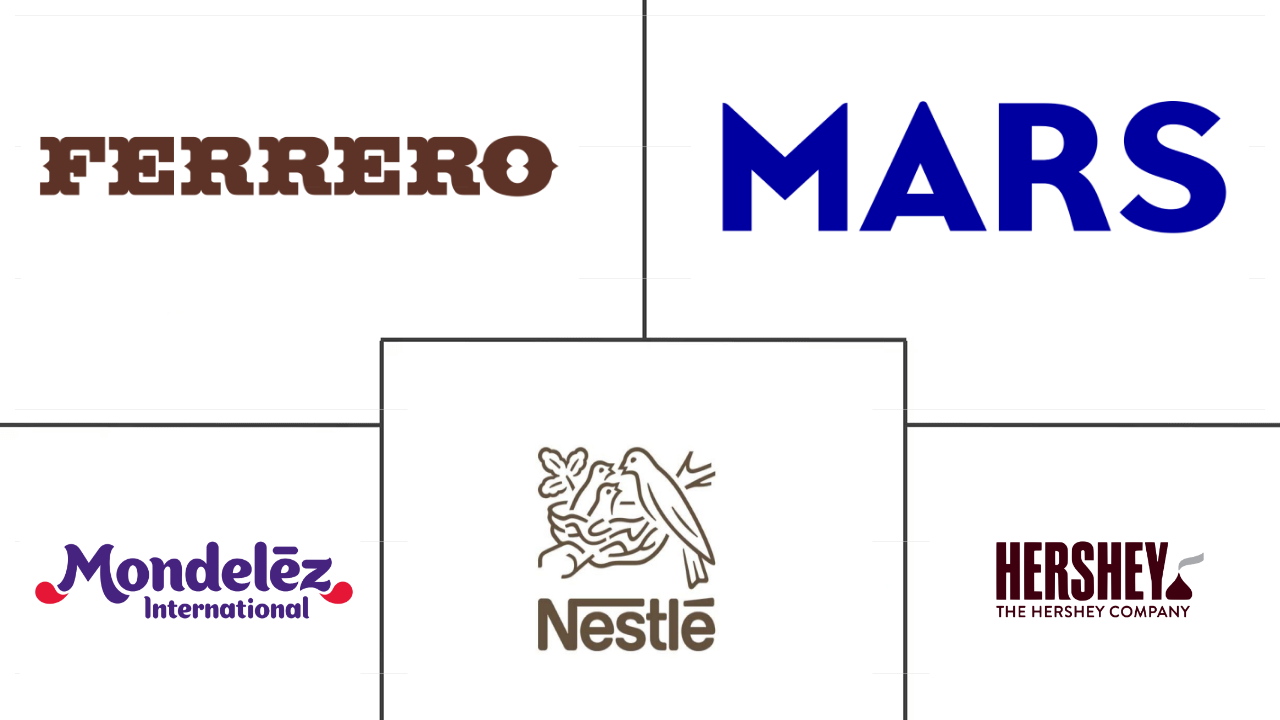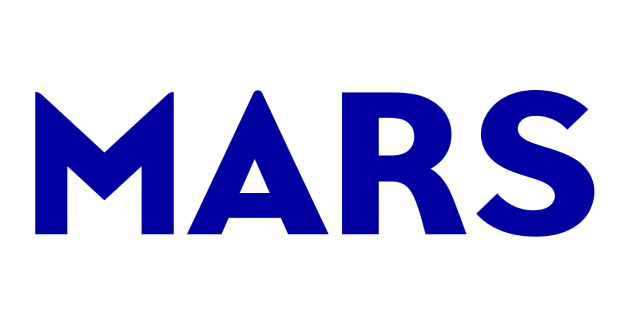Market Size of chocolate Industry
|
|
Study Period | 2018 - 2030 |
|
|
Market Size (2024) | USD 109.13 Billion |
|
|
Market Size (2030) | USD 145.14 Billion |
|
|
Largest Share by Distribution Channel | Supermarket/Hypermarket |
|
|
CAGR (2024 - 2030) | 4.87 % |
|
|
Largest Share by Region | Europe |
Major Players |
||

|
||
|
*Disclaimer: Major Players sorted in no particular order |
Chocolate Market Analysis
The Chocolate Market size is estimated at 109.13 billion USD in 2024, and is expected to reach 145.14 billion USD by 2030, growing at a CAGR of 4.87% during the forecast period (2024-2030).
109.13 Billion
Market Size in 2024 (USD)
145.14 Billion
Market Size in 2030 (USD)
3.78 %
CAGR (2018-2023)
4.87 %
CAGR (2024-2030)
Largest Segment by Confectionery Variant
63.99 %
value share, Milk and White Chocolate, 2023
The innovative flavor offerings possible in white chocolate, followed by the increasing preference for varied taste profiles globally, are expected to drive segmental growth.
Largest Segment by Region
43.48 %
value share, Europe, 2023
Growing popularity of artisanal chocolate confectioneries, and rising consumer preference for organic and value-added natural ingredients, is propelling the share in Europe.
Fastest-growing Segment by Confectionery variant
5.48 %
Projected CAGR, Dark Chocolate, 2024-2030
Rising interest among consumers toward the nutrition content and stress-relieving ability of dark chocolate, along with increasing health consciousness, is driving the demand.
Fastest-growing Segment by Region
5.81 %
Projected CAGR, Middle East, 2024-2030
The large expatriate population in Middle Eastern countries, such as the United Arab Emirates and Saudi Arabia, contributed to the growing demand for chocolates in the region.
Leading Market Player
16.37 %
market share, Mars Incorporated, 2022

The products offered by Mars have various national and international certifications with a special focus on quality and high standards making them market leader in the region.
Supermarkets and hypermarkets are the leading distribution channel for seasonal offers and discounted purchases, with Y-o-Y sales increasing steadily
- Supermarkets and hypermarkets are the leading distribution channels for chocolate sales globally. Sales through supermarkets and hypermarkets are anticipated to record a CAGR of 4.67% during the forecast period to reach a market value of USD 60,579.94 million by 2030. Consumer preference for these channels is driven by seasonal offers, discounts on bulk purchases, and access to diversified products through a dedicated section of chocolate products. Due to the large shelf space, these channels allow access to local and international brands.
- Convenience stores are the second most widely preferred distribution channels after supermarkets and hypermarkets to purchase chocolates. In 2023, the segment had a 30.48% volume share in the overall distribution channels. The broader reach and easy access to private label brands drive the consumer preference for traditional grocery stores over other retail channels. The sales value of chocolates through convenience stores is anticipated to record a CAGR of 4.59% during 2023-2030.
- The sales value of chocolate confectionery through the online channel is projected to expand at the highest CAGR of 5.72% during 2023-2030, reaching USD 9,393.62 million in 2030. Being the largest chocolate-consuming regions, Europe and North America collectively had a 73.47% share of global chocolate sales through online channels in terms of value in 2023. The increasing number of internet users influences the evolving role of online channels in chocolate confectionery purchases. In 2022, 68% of European consumers aged 16 to 74 bought online goods or services for personal use. ASDA, Tesco, and Sainsbury's are leading online grocery stores in Europe.
Europe and North America lead the chocolate market globally, with a value share of almost 80% during the study period
- Globally, the sales value of chocolate registered a growth rate of 4.42% in 2023 compared to 2022. Chocolates have gained immense traction across the world due to their various health benefits, easy accessibility, and the availability of a wide range of chocolates.
- Compared to other regions, Europe plays a major role in the sales of chocolates and registered a growth rate of 12.37% from 2020 to 2023 by value. The growth is attributed to growing consumer’s preference for premium chocolates and sustainable chocolates. As of 2022, more than 60% of consumers in the region paid for sustainably made products, including chocolates.
- European countries show significantly higher averages in per capita consumption of chocolates. Europe was responsible for processing 35% of the world’s cacao and consumed a whopping 45% of world chocolate consumption in 2022. The world’s highest chocolate consumption nations are found in Europe. Switzerland consumed the most chocolate with a per capita consumption of 11 kg in 2022. The chocolate market in Europe registered a CAGR of 4.41% during the forecast period.
- North America is the second-largest chocolate market globally. The sales value of chocolates is anticipated to grow by 29.40% in 2027 compared to 2022. Americans have a strong affinity for chocolate, and it is often associated with celebrations, special occasions, and major holidays like Easter, Christmas, and Valentine’s Day, driving chocolate sales in the region. More options in package sizes of 200 calories or less are available during the holiday season. Most consumers in the region gift chocolates on Valentine’s Day. In 2022, more than 27% of Americans were gifted chocolate on Valentine’s Day.
Chocolate Industry Segmentation
Dark Chocolate, Milk and White Chocolate are covered as segments by Confectionery Variant. Convenience Store, Online Retail Store, Supermarket/Hypermarket, Others are covered as segments by Distribution Channel. Africa, Asia-Pacific, Europe, Middle East, North America, South America are covered as segments by Region.
- Supermarkets and hypermarkets are the leading distribution channels for chocolate sales globally. Sales through supermarkets and hypermarkets are anticipated to record a CAGR of 4.67% during the forecast period to reach a market value of USD 60,579.94 million by 2030. Consumer preference for these channels is driven by seasonal offers, discounts on bulk purchases, and access to diversified products through a dedicated section of chocolate products. Due to the large shelf space, these channels allow access to local and international brands.
- Convenience stores are the second most widely preferred distribution channels after supermarkets and hypermarkets to purchase chocolates. In 2023, the segment had a 30.48% volume share in the overall distribution channels. The broader reach and easy access to private label brands drive the consumer preference for traditional grocery stores over other retail channels. The sales value of chocolates through convenience stores is anticipated to record a CAGR of 4.59% during 2023-2030.
- The sales value of chocolate confectionery through the online channel is projected to expand at the highest CAGR of 5.72% during 2023-2030, reaching USD 9,393.62 million in 2030. Being the largest chocolate-consuming regions, Europe and North America collectively had a 73.47% share of global chocolate sales through online channels in terms of value in 2023. The increasing number of internet users influences the evolving role of online channels in chocolate confectionery purchases. In 2022, 68% of European consumers aged 16 to 74 bought online goods or services for personal use. ASDA, Tesco, and Sainsbury's are leading online grocery stores in Europe.
| Confectionery Variant | |
| Dark Chocolate | |
| Milk and White Chocolate |
| Distribution Channel | |
| Convenience Store | |
| Online Retail Store | |
| Supermarket/Hypermarket | |
| Others |
| Region | |||||||||||||||
| |||||||||||||||
| |||||||||||||||
| |||||||||||||||
| |||||||||||||||
| |||||||||||||||
|
Chocolate Market Size Summary
The chocolate market is experiencing steady growth, driven by consumer preferences and evolving distribution channels. Supermarkets and hypermarkets dominate the global chocolate sales landscape, offering seasonal promotions and a wide range of products, including both local and international brands. Convenience stores also play a significant role, appealing to consumers with easy access to private label brands. The online channel is emerging as a rapidly growing segment, particularly in Europe and North America, where a significant portion of chocolate sales occurs. The increasing number of internet users is enhancing the role of online platforms in chocolate purchases, with major grocery stores like ASDA, Tesco, and Sainsbury's leading the charge in Europe.
Regionally, Europe stands out as the largest chocolate market, with high per capita consumption and a strong preference for premium and sustainable chocolates. The region's consumers are increasingly willing to pay for sustainably made products, contributing to its robust market growth. North America follows as the second-largest market, with chocolate being a staple in celebrations and holidays. The market is moderately consolidated, with major players like Ferrero International, Mars Incorporated, Mondelēz International, Nestlé SA, and The Hershey Company holding significant shares. Fluctuations in raw material prices and consumer preferences for organic and Fairtrade-certified chocolates are influencing retail prices and buying behavior globally.
Chocolate Market Size - Table of Contents
-
1. MARKET SEGMENTATION (includes market size in Value in USD and Volume, Forecasts up to 2030 and analysis of growth prospects)
-
1.1 Confectionery Variant
-
1.1.1 Dark Chocolate
-
1.1.2 Milk and White Chocolate
-
-
1.2 Distribution Channel
-
1.2.1 Convenience Store
-
1.2.2 Online Retail Store
-
1.2.3 Supermarket/Hypermarket
-
1.2.4 Others
-
-
1.3 Region
-
1.3.1 Africa
-
1.3.1.1 By Country
-
1.3.1.1.1 Egypt
-
1.3.1.1.2 Nigeria
-
1.3.1.1.3 South Africa
-
1.3.1.1.4 Rest of Africa
-
-
-
1.3.2 Asia-Pacific
-
1.3.2.1 By Country
-
1.3.2.1.1 Australia
-
1.3.2.1.2 China
-
1.3.2.1.3 India
-
1.3.2.1.4 Indonesia
-
1.3.2.1.5 Japan
-
1.3.2.1.6 Malaysia
-
1.3.2.1.7 New Zealand
-
1.3.2.1.8 South Korea
-
1.3.2.1.9 Rest of Asia-Pacific
-
-
-
1.3.3 Europe
-
1.3.3.1 By Country
-
1.3.3.1.1 Belgium
-
1.3.3.1.2 France
-
1.3.3.1.3 Germany
-
1.3.3.1.4 Italy
-
1.3.3.1.5 Netherlands
-
1.3.3.1.6 Russia
-
1.3.3.1.7 Spain
-
1.3.3.1.8 Switzerland
-
1.3.3.1.9 Turkey
-
1.3.3.1.10 United Kingdom
-
1.3.3.1.11 Rest of Europe
-
-
-
1.3.4 Middle East
-
1.3.4.1 By Country
-
1.3.4.1.1 Bahrain
-
1.3.4.1.2 Kuwait
-
1.3.4.1.3 Oman
-
1.3.4.1.4 Qatar
-
1.3.4.1.5 Saudi Arabia
-
1.3.4.1.6 United Arab Emirates
-
1.3.4.1.7 Rest of Middle East
-
-
-
1.3.5 North America
-
1.3.5.1 By Country
-
1.3.5.1.1 Canada
-
1.3.5.1.2 Mexico
-
1.3.5.1.3 United States
-
1.3.5.1.4 Rest of North America
-
-
-
1.3.6 South America
-
1.3.6.1 By Country
-
1.3.6.1.1 Argentina
-
1.3.6.1.2 Brazil
-
1.3.6.1.3 Rest of South America
-
-
-
-
Chocolate Market Size FAQs
How big is the Global Chocolate Market?
The Global Chocolate Market size is expected to reach USD 109.13 billion in 2024 and grow at a CAGR of 4.87% to reach USD 145.14 billion by 2030.
What is the current Global Chocolate Market size?
In 2024, the Global Chocolate Market size is expected to reach USD 109.13 billion.

